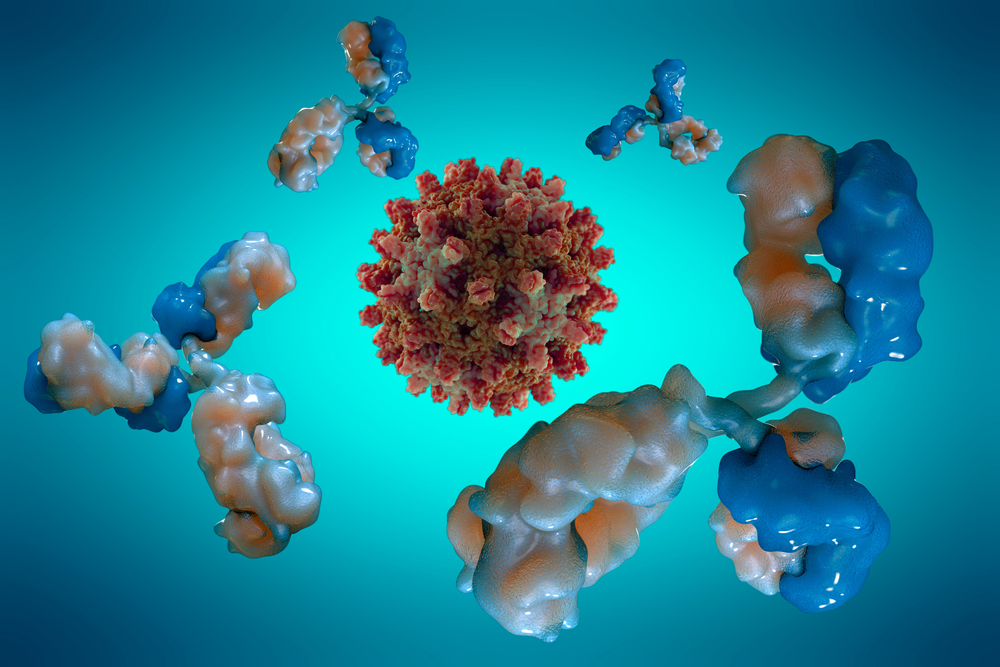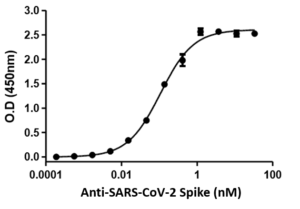ELISA: Binding of Anti-SARS-CoV-2 Spike protein, IgA to immobilized SARS-CoV-2 Spike protein RBD determined by ELISA.
Human IgA Anti-SARS-CoV-2 Spike Antibody (A60H)
Price range: $493.99 through $1,292.77 excl. VAT
Anti-SARS-CoV-2 Spike antibody (A60H) is a recombinant monoclonal antibody that recognizes the SARS-CoV and SARS-CoV-2 Spike glycoprotein, the causative agent of COVID-19. Antibody binds to both SARS-CoV and SARS-CoV-2 with high affinity at the Receptor Binding Domain (RBD) in the S1 subunit of the Spike protein.
HUMAN IGA ANTI-SARS-COV-2 SPIKE ANTIBODY (A60H)
Human IgA Anti-SARS-CoV-2 Spike antibody (A60H) is a recombinant monoclonal antibody that recognizes the SARS-CoV and SARS-CoV-2 Spike glycoprotein, the causative agent of COVID-19. Antibody binds to both SARS-CoV and SARS-CoV-2 with high affinity at the Receptor Binding Domain (RBD) in the S1 subunit of the Spike protein.
PRODUCT DETAILS – HUMAN IGA ANTI-SARS-COV-2 SPIKE ANTIBODY (A60H)
- Recombinant anti SARS-CoV-2 Spike IgA antibody
- Isotype – Human IgA
- Binds the SARS-CoV Spike protein as well as SARS-CoV-2 (COVID-19) Spike protein
- Presented in PBS
- Suitable for use in ELISA
BACKGROUND
Human coronaviruses are the major cause of upper respiratory tract illness. They are positive-stranded RNA viruses, and contain the largest viral RNA genomes known to date (27-31 kb). SARS (severe acute respiratory syndrome) and COVID-19 are both caused by human coronaviruses, SARS-CoV and SARS-CoV-2, respectively. The genome of SARS-CoV-2 shares 82% nucleotide identity with human SARS-CoV and 89% with bat SARS-like-CoVZXC21 (Lu et al., 2020; Zhao et al., 2020). However, it displays lower pathogenicity and higher human to human transmissibility (Li et al., 2020). The coronavirus genome encodes four structural proteins: the spike (S) protein, nucleocapsid (N) protein, membrane (M) protein, and the envelope (E) protein. Cell entry is the first step in cross-species transmission and SARS-CoV-2 is likely to infect lung type II alveolar cells, which may explain the severe alveolar damage observed after infection (Zhao et al., 2020). Both SARS-CoV and SARS-CoV-2 uses the spike (S) protein to gain entry into host cells and it has been shown that the spike RBD binds the entry receptor angiotensin-converting enzyme 2 (ACE2) on infected cells. It is predicted that SARS-CoV-2 recognizes human ACE2 more efficiently than SARS -CoV (Wan et al., 2020). Therefore, the S protein is considered a key target for vaccine development (Li et al, 2020).
REFERENCES
- Li Q, Guan X, Wu P, et al. (2020). Early Transmission Dynamics in Wuhan, China, of Novel Coronavirus-Infected Pneumonia. N Engl J Med. 2020;382(13):1199–1207.
- Li H, Zhou Y, Zhang M, Wang H, Zhao Q, Liu J. (2020). Updated approaches against SARS-CoV-2. Antimicrob Agents Chemother. 2020;AAC.00483-20.
- Lu, R., Zhao, X., Li, J., Niu, P., Yang, B., Wu, H., Wang, W., Song, H., Huang, B., Zhu, N., et al. (2020). Genomic characterisation and epidemiology of 2019 novel coronavirus: implications for virus origins and receptor binding. Lancet 395, 565–574.
- Wan Y, Shang J, Graham R, Baric RS, Li F. Receptor Recognition by the Novel Coronavirus from Wuhan: an Analysis Based on Decade-Long Structural Studies of SARS Coronavirus. J Virol. 2020;94(7):e00127-20.
- Zhao et al. (2020). Single -cell RNA 2expression profiling of ACE2, the putative receptor of Wuhan 2019 -nCov. BioRxiv.
- Zhou P, Yang XL, Wang XG, et al. A pneumonia outbreak associated with a new coronavirus of probable bat origin. Nature. 2020;579(7798):270–273.


